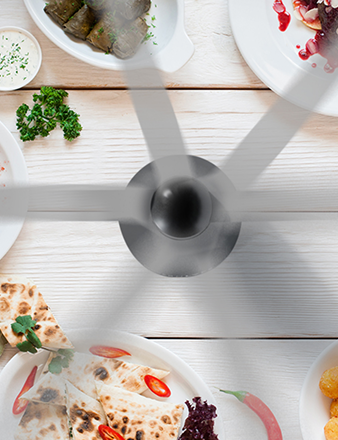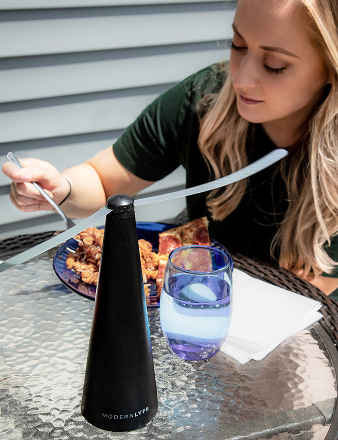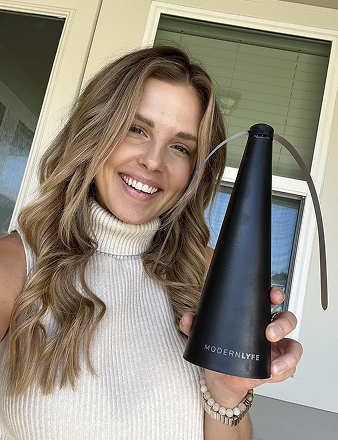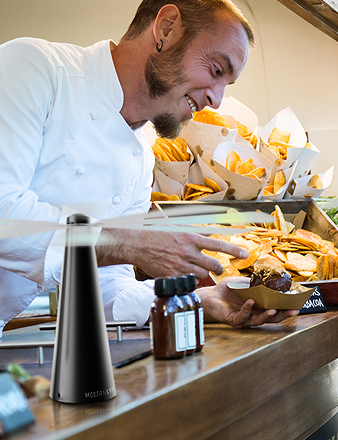To eliminate fruit flies, you have to destroy their source. That means getting rid of their food supply: overripe fruit, sticky spills, and the organic gunk that builds up in drains. Trapping the adult flies is only a temporary fix. The real solution is to break their breeding cycle.
Understanding the Enemy: Why You Have Fruit Flies
A few fruit flies in your kitchen or bar are a warning sign. These pests are experts at finding the smallest spill or forgotten piece of produce. To win the fight, you need to understand your opponent.
Fruit flies typically hitch a ride into your space on produce. A single piece of fruit can carry invisible eggs, just waiting for the fruit to ripen and ferment. Once that happens, the lifecycle begins.
The Rapid Lifecycle
The reason a few flies become a swarm so quickly is their reproductive speed. A single female fruit fly can lay up to 500 eggs, and those eggs can mature into adults in as little as a week.
Here’s the breakdown:
- Eggs: Laid on the surface of fermenting food or moist organic material.
- Larvae: Hatch in 24-30 hours and begin feeding on decaying matter.
- Pupae: After a few days, larvae move to a drier spot to pupate.
- Adults: Emerge shortly after, ready to mate and repeat the cycle.
This rapid timeline means that while you're dealing with the adults, a new generation is already developing in a hidden location.
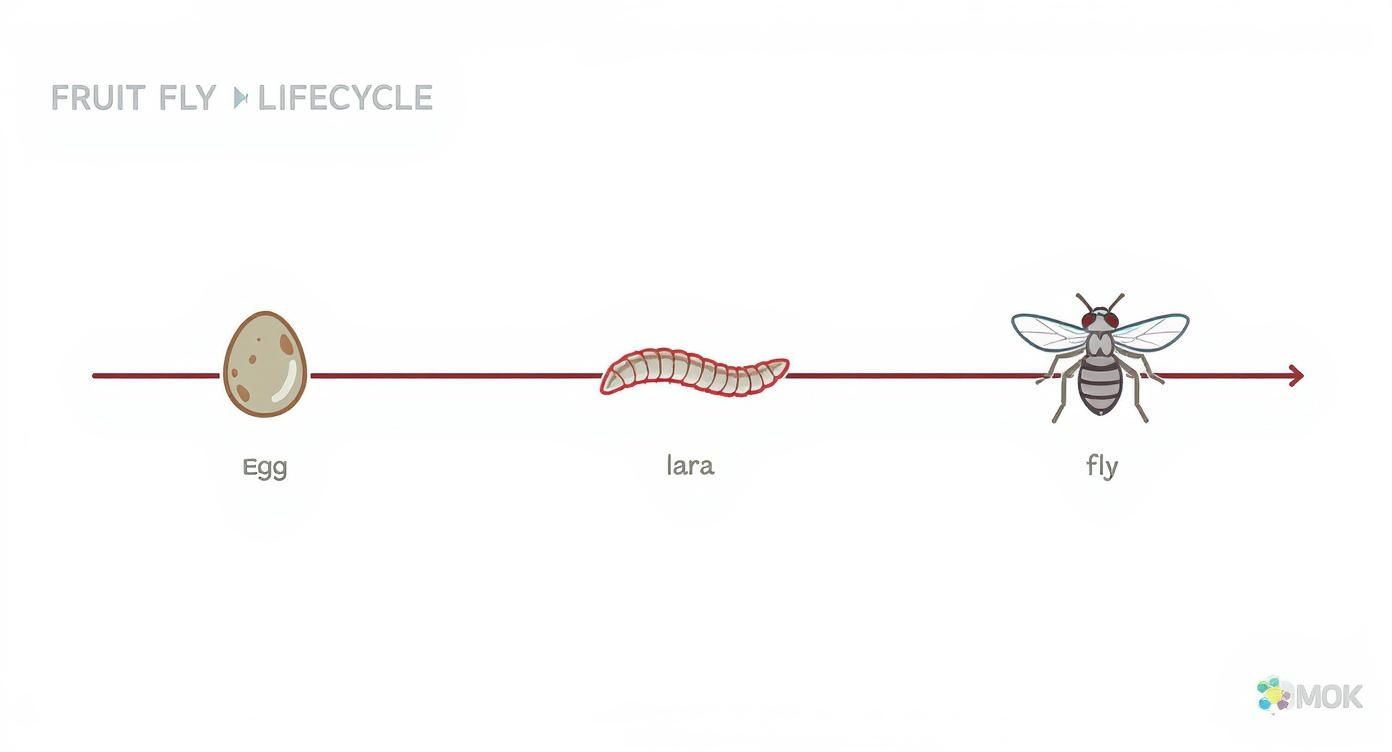
Common Breeding Grounds
The fruit bowl is an obvious culprit, but fruit flies are resourceful. They can breed anywhere with moisture and fermenting organic material. To eliminate them, you have to think like a fly.
Common hidden breeding spots include:
- Sink Drains & Garbage Disposals: Food particles create a slimy film inside pipes—a perfect environment for larvae.
- Damp Sponges & Dishcloths: Left out, these can hold enough moisture and bacteria to support a breeding cycle.
- Bottom of Trash Cans: Sticky residue from old garbage bags creates an ideal nursery.
- Recycling Bins: Small amounts of leftover soda, beer, or wine in unrinsed containers are enough to attract them.
The key takeaway: Fruit flies don't need a whole rotting apple. A smear of ketchup or a bit of spilled juice is all it takes.
Persistent odors can also signal moisture problems that attract pests. Learning how to eliminate old musty smells at home can help you address underlying issues that make your space more inviting to them.
Proactive Prevention: Stop Fruit Flies Before They Start
The most effective way to eliminate fruit flies is to prevent them from taking hold in the first place. Proactive sanitation is far more effective than reacting to an established infestation. A single forgotten banana slice can trigger a major problem.
Fruit flies often enter as microscopic eggs on fruits and vegetables. Once that produce overripens, their lifecycle kicks into high gear, turning a minor issue into a major headache.

Fortify Your Defenses With Deep Sanitation
To get ahead of fruit flies, you need to think like one. They seek out moisture and fermenting organic matter, often in overlooked places. A quick wipe of visible surfaces isn't enough. A consistent, deep-cleaning routine is your best defense.
Consider a busy kitchen. Counters get wiped, but what about the splashes of syrup behind the bar gun or the food scraps under the prep table? These are the havens where fruit flies set up camp, needing only a thin film of organic residue to breed.
For any food business, a rigorous commercial kitchen cleaning checklist is essential. The same principles are just as critical for a home kitchen.
Master Produce and Waste Management
How you manage food and trash is a critical part of the puzzle. Smart storage and disposal habits cut off the fruit fly food supply, leaving them nowhere to lay their eggs.
Start at the grocery store. Inspect produce and leave any bruised or overripe items behind. At home, don't just toss fruit into a bowl on the counter.
Adopt these game-changing habits:
- Refrigerate Ripe Produce: Once fruits like bananas and tomatoes are ripe, move them to the fridge to slow the fermentation process.
- Use Sealed Containers: Store onions and potatoes in cool, dark, well-ventilated bins, not in plastic bags where moisture can get trapped.
- Rinse Recyclables: Quickly rinse soda cans, wine bottles, and yogurt cups to remove sugary residue that attracts pests.
- Take Out the Trash Daily: Especially in warm weather or if you've disposed of food scraps, make this a daily ritual.
The goal is to break the cycle. By removing their food and breeding sites every day, you prevent any adult flies from establishing a new generation.
This constant vigilance is what separates an occasional stray fly from a persistent infestation.
Fruit Fly Prevention Checklist
This checklist organizes essential tasks into daily, weekly, and monthly routines to keep your space consistently unwelcoming to fruit flies.
| Frequency | Task Description | Why It Works |
|---|---|---|
| Daily | Wipe down all counters, tables, and food prep surfaces with a sanitizer. | Removes sticky films and crumbs that provide a food source. |
| Daily | Take out all trash and recycling, especially bags with organic waste. | Eliminates the primary breeding ground for new generations of flies. |
| Daily | Check produce for ripeness; refrigerate or discard overripe items. | Stops the fermentation process that attracts fruit flies to lay eggs. |
| Daily | Clean up spills immediately, especially sugary liquids. | Prevents the creation of new feeding spots. |
| Weekly | Deep clean floor drains with an enzymatic cleaner and a stiff brush. | Destroys the organic slime buildup where larvae develop. |
| Weekly | Clean under and behind appliances (refrigerators, stoves, prep tables). | Removes hidden food debris and moisture that you might otherwise miss. |
| Weekly | Wash out trash and recycling bins with soap and water. | Gets rid of any lingering residue that could attract pests. |
| Monthly | Inspect and repair any torn window or door screens. | Seals off physical entry points for flies from outside. |
| Monthly | Check for and repair any leaks under sinks or around plumbing. | Eliminates the moisture that fruit flies need to survive and breed. |
Sticking to a schedule like this turns prevention into a habit, making it much harder for an infestation to gain a foothold.
Seal Entry Points and Eliminate Breeding Grounds
Fruit flies are small enough to get through tiny cracks. A thorough inspection of your property can help you find and seal these entry points, creating a physical barrier.
Focus on these key areas:
- Window and Door Screens: Check for small tears or holes and patch them immediately. Ensure door sweeps create a tight seal against the threshold.
- Drains and Disposals: Drains are a prime breeding ground. Once a week, scrub them with a stiff brush and an enzymatic drain cleaner to break down organic buildup where larvae grow. Pouring boiling water down them also helps.
- Hidden Moisture Zones: Hunt for leaks under sinks, behind appliances, or around plumbing. Fix any drips and dry the areas completely. Don't forget the refrigerator's drip pan—it's a commonly overlooked source of moisture.
When you combine meticulous cleaning, smart food management, and physically sealing entryways, you build a fortress that fruit flies can't breach.
What to Do When You Already Have an Infestation
If you're past prevention and dealing with an active infestation, it's time to go on the offensive. Getting rid of fruit flies requires a two-pronged attack: trap the adults while simultaneously eliminating their breeding grounds.
Attacking from both sides is the only way to win. Setting a trap is a start, but if you ignore their nests, a new generation will simply replace the ones you catch. You must be aggressive on both fronts.
Start with Simple, Effective DIY Traps
You can build a powerful fruit fly trap using household items. Fruit flies are hardwired to seek the smell of fermentation, which you can easily use against them.
The classic apple cider vinegar (ACV) trap is effective for a reason. Its fermented scent is irresistible to fruit flies.
How to make one:
- Get a small jar or bowl.
- Pour in an inch of apple cider vinegar. Unfiltered ACV often works best, but any kind will do.
- Add a single drop of dish soap. This is the key. It breaks the vinegar's surface tension, so when flies land, they fall in and drown.
- Cover with plastic wrap. Secure it with a rubber band and poke a few small holes in the top. The scent escapes, flies get in, but they can't get out.
Place several of these traps in hotspots: near the fruit bowl, by the sink, and next to the trash can. No ACV? A little red wine works just as well.
Choosing the Right Commercial Trap
While DIY traps are great, a serious infestation may require more firepower. We cover many options in our guide to the best fly trap for fruit flies, but here are a few tips.
When shopping for a trap, consider:
- Non-toxic lures. In kitchens and dining areas, choose a trap that uses a food-based attractant, not a chemical pesticide.
- Discreet design. Many modern traps are designed to blend in with your decor.
- Sticky traps. These often use a light or scent to draw flies onto a disposable glue board, offering a mess-free and effective solution.
Pro-Tip: Skip bug zappers and broad-spectrum insecticide sprays. Zappers are unsanitary in food prep areas, and sprays are a temporary fix that won't touch the larvae hidden in breeding sites. A targeted approach is always better.
Beyond Traps: Destroy the Source
Catching adult flies is satisfying, but it's only half the battle. To eliminate them for good, you must find and destroy their nursery.
The most common breeding ground is the organic gunk in your kitchen drain. Over time, a biofilm builds up inside the pipe, creating a perfect habitat for larvae.
How to properly clean your drains:
- Pour a kettle of boiling water down the drain to loosen grime.
- Use a stiff drain brush to physically scrub the inside of the pipe as far down as you can reach.
- Finish with an enzymatic drain cleaner. These use natural enzymes to digest the organic matter, eliminating the larvae's food source. Do not use bleach, as it flows past the sludge without removing it.
This combined strategy—trapping adults, destroying breeding sites, and maintaining cleanliness—is what solves the problem. This approach is backed by large-scale agricultural research. Studies have shown that combining sanitation with targeted baiting can decimate fruit fly populations. One project saw infestation rates fall from nearly 70% to less than 0.2% in six months. You can read more about these pest control findings and apply the same principles at home or in your business.
Using Airflow as a Modern Pest Solution
Instead of reacting to an infestation with sprays or traps, create an environment where fruit flies simply can't function. The principle of airflow offers a continuous, food-safe line of defense.
Specialized fly fans, like those from Modern Lyfe, generate a gentle but persistent air current that disrupts the weak flight of a fruit fly. These pests are poor fliers, and even a soft breeze makes it impossible for them to navigate, land on food, or find a place to lay eggs.
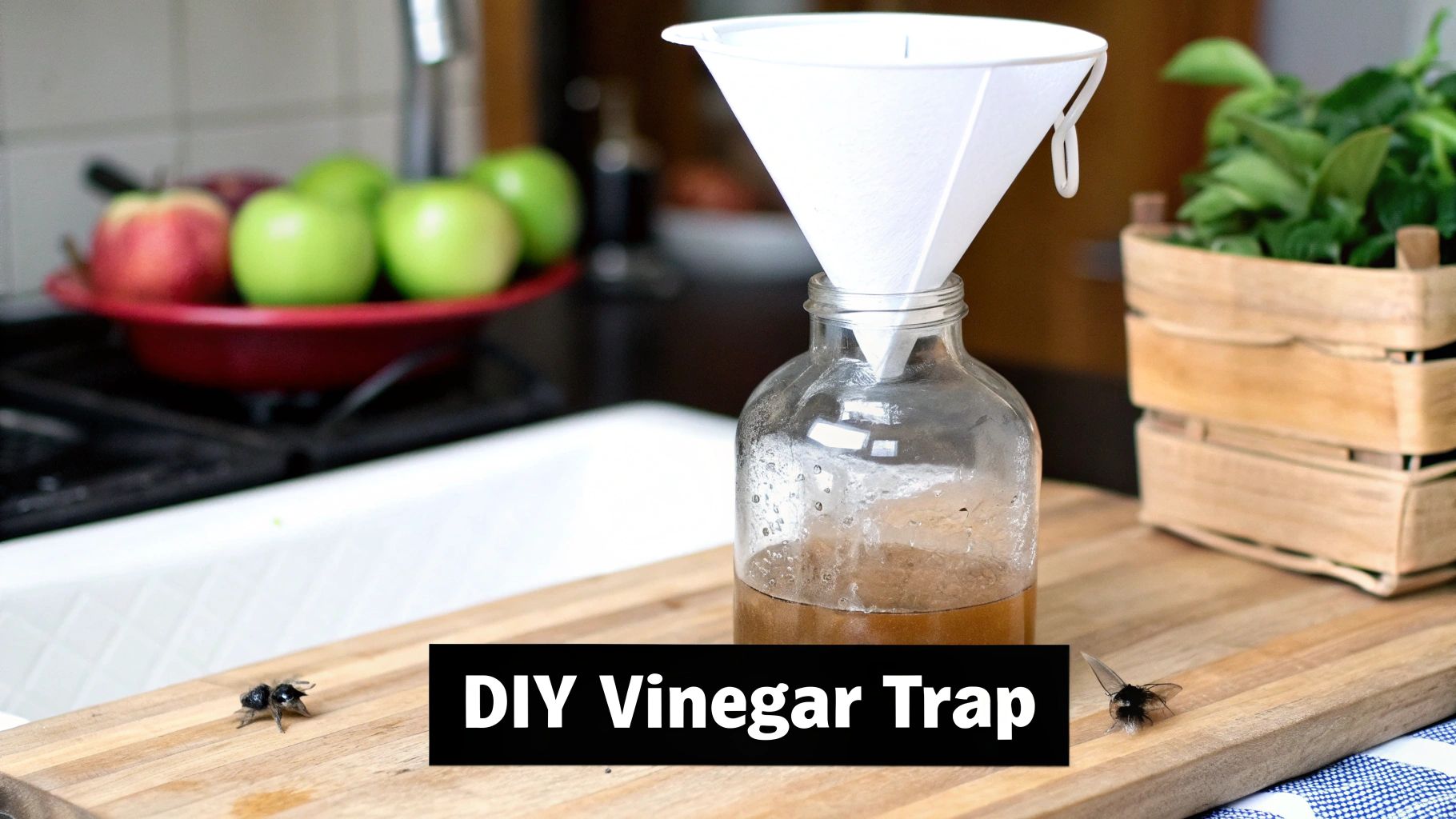
This method shifts the focus from trapping to active prevention. You're not luring them in; you're creating an invisible barrier that protects your food and surfaces 24/7. It's a clean, quiet, and effective way to control your environment.
Ideal Placement for Maximum Effectiveness
Strategic placement is key. The goal is to generate a protective shield of moving air directly over the areas that attract fruit flies.
In Your Home Kitchen:
- Near the Fruit Bowl: This is ground zero. A fan here makes it impossible for them to land on ripening produce.
- By the Sink: Flies are drawn to drains and damp spots. A fan will deter them from breeding in this area.
- On a Kitchen Island: Keep your entire prep and serving workspace protected and fly-free.
In a Commercial Setting:
- Buffet Lines: Place a fan every few feet along the buffet to keep the entire spread clear and hygienic.
- Bar Tops: Fruit flies are drawn to sweet residues. A fan at each station keeps them from bothering customers and contaminating ingredients.
- Outdoor Patios: Place a fan on each table to protect meals and drinks, ensuring a more pleasant dining experience.
The key is consistency. A network of strategically placed fans can create a comprehensive defense, effectively turning your entire service area into a no-fly zone.
Airflow vs. Traditional Traps: A Clear Winner
While traditional traps can help, they mean you're always playing catch-up. An airflow-based solution offers significant advantages, especially in settings with open food. It's a full preventative system.
Here's how a modern fly fan compares to old-school traps:
| Feature | Modern Lyfe Fly Fans | Traditional Traps (Vinegar/Sticky) |
|---|---|---|
| Action | Proactive Prevention: Creates a constant barrier that stops flies before they land. | Reactive Removal: Only lures and captures flies that are already present. |
| Safety | 100% Food-Safe: Uses only air. No chemicals, poisons, or sticky substances near food. | Potential Contamination: Bait can spoil, spill, or attract other pests. |
| Aesthetics | Sleek and Discreet: Designed to blend into modern decor. | Unsightly: Quickly becomes a gross visual of dead insects. |
| Maintenance | Minimal: Requires only an occasional battery change or recharge. | Constant: Needs to be refilled, cleaned, and replaced regularly. |
This modern approach changes how you deal with pests. You aren't just killing the fruit flies you see; you're building an environment where they are physically unable to thrive.
Advanced Strategies for the Hospitality Industry
In a restaurant, bar, or hotel, fruit flies are more than a nuisance—they're a threat to your reputation and revenue. A single gnat can ruin a guest's experience. The stakes are too high to wait for a problem to appear.
An Integrated Pest Management (IPM) program is the professional-grade solution. It's a proactive, preventative system designed for a commercial setting, giving your staff the tools to eliminate fruit flies before a customer ever sees one.
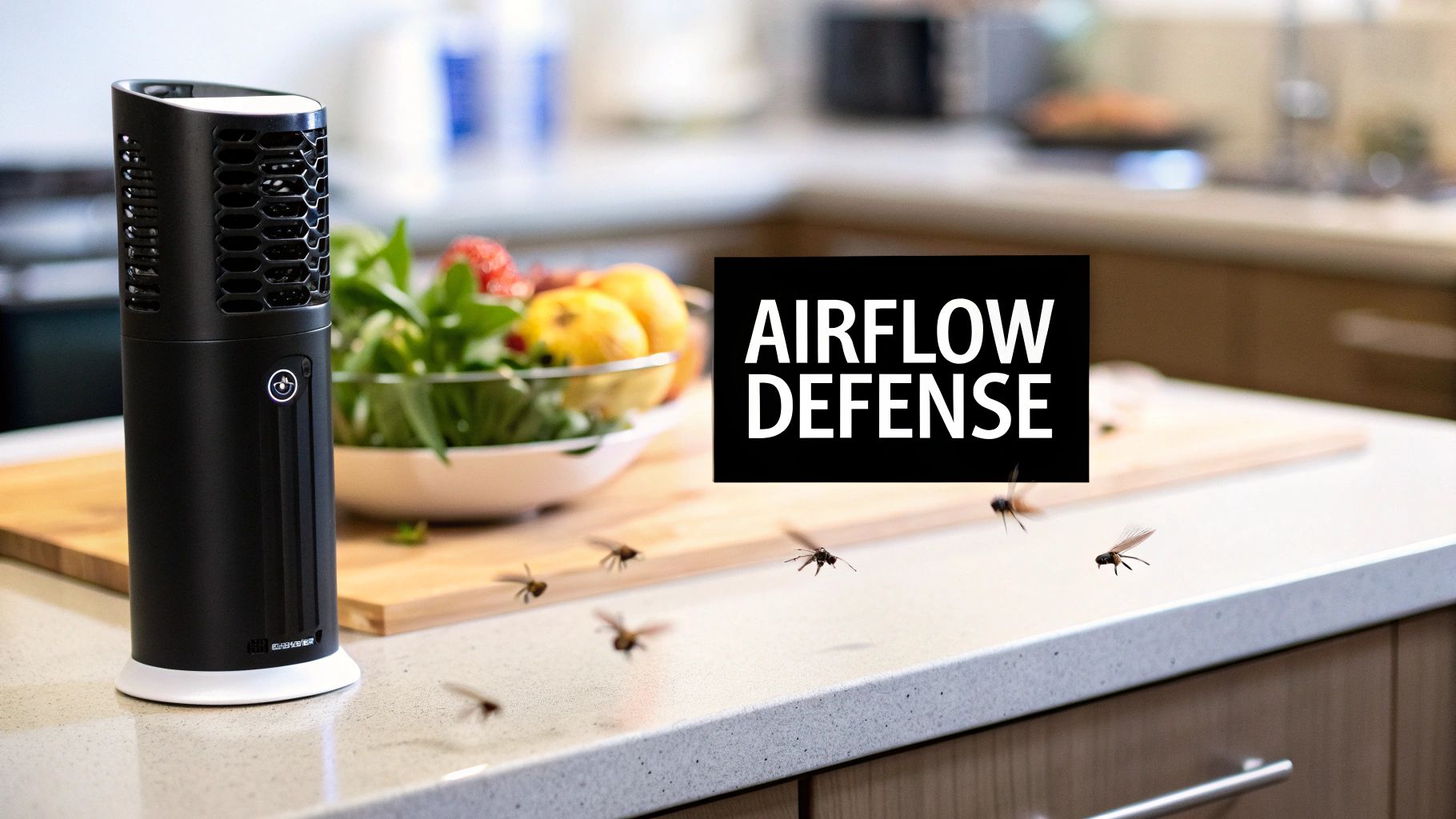
Empower Your Team Through Proactive Training
Your staff is your most effective line of defense. With proper training, every employee becomes an active part of your pest control strategy. The goal is to integrate sanitation so deeply into the daily workflow that it becomes second nature.
Effective training should cover:
- Source Identification: Teach your team to spot potential breeding grounds beyond the obvious, such as slime in floor drains, residue in soda gun holsters, and the film at the bottom of recycling bins.
- Rapid Spill Response: Emphasize that every spill, no matter how small, must be cleaned immediately to prevent it from becoming a food source.
- Strict Closing Protocols: Ensure everyone understands the importance of nightly deep-cleaning routines, from covering liquor bottles to scrubbing bar mats until they are spotless.
A well-trained team creates a culture of cleanliness that customers notice and pests hate. Our detailed guide on fly control for restaurants offers more specific strategies for food service environments.
The Bar Area: A Front-of-House Battleground
The bar is often ground zero for fruit fly problems, offering a perfect storm of sugar, moisture, and organic material from garnishes. Meticulous bar hygiene is non-negotiable.
These critical nightly tasks must happen without fail:
- Pour Spouts & Bottles: At the end of every shift, remove, soak, and clean all liquor pour spouts. Let them dry overnight and ensure bottles are capped or covered.
- Drip Trays & Soda Guns: Empty and scrub drip trays daily. Thoroughly clean soda gun nozzles and their holsters to remove sticky syrup residue.
- Garnish Stations: Store all fruit garnishes in sealed containers and refrigerate them overnight. Never leave an open tray of garnishes on the bar after closing.
Imagine a busy cocktail bar where the staff follows a strict closing checklist. They clean every pour spout, scrub the mats, and seal all garnishes. This diligence prevents spills from becoming a breeding ground, ensuring a pest-free bar for the next day.
Back-of-House Diligence: Produce and Waste
What happens in the back of the house is just as crucial for keeping your establishment fly-free. This is where produce arrives and waste accumulates.
Implement strict rules for produce. Train kitchen staff to inspect every delivery for over-ripe or damaged items before accepting it. Use a first-in, first-out (FIFO) rotation system to prevent produce from being forgotten and left to rot.
Waste management is the other pillar. All indoor trash cans need tight-fitting lids and should be emptied constantly. Keep the outdoor dumpster area clean with the lids closed to avoid attracting pests that can eventually find their way inside. In the U.S. alone, over 1.5 billion kilograms of produce are lost to fruit flies each year, highlighting the seriousness of the threat.
Your Top Fruit Fly Questions, Answered
Even after cleaning and setting traps, you might still have questions. Getting the right answers can be the difference between a temporary fix and a permanent solution.
Understanding why fruit flies appeared is the key to keeping them away for good.
Why Did Fruit Flies Suddenly Appear?
Fruit flies don't materialize out of thin air. They are almost always brought into your home as microscopic eggs or larvae on fresh produce.
A single piece of fruit with a small bruise can be the Trojan horse. Once it sits on your counter and overripens, the eggs hatch. Their rapid breeding cycle then kicks in, making it feel like a sudden invasion.
Can Fruit Flies Live Without Food?
Not for long. More importantly, they cannot reproduce without it. An adult fruit fly's life is a one-to-two-week race to find fermenting organic material to lay its eggs on.
While an adult might survive a day or so without a meal, the entire lifecycle depends on a food source. This is why cleaning is so critical. When you eliminate their food and breeding sites, you shut down their entire operation. The existing adults will die off, and no new generation can replace them.
Remember this: if you see fruit flies, they have a food source somewhere. Your job is to find it. Once the source is gone, the population will collapse.
Are Fruit Flies Harmful?
They don't bite or sting, but they are not harmless. Fruit flies frequent unsanitary places like slimy drains and rotting garbage before landing on your food or prep surfaces.
This makes them vectors for bacteria and pathogens, posing a health risk in any kitchen.
- Contamination Risk: They can transfer germs from a dirty garbage can to the fresh food you're preparing.
- Reputation Damage: For a business, a visible fruit fly problem can instantly destroy a customer's perception of your cleanliness and quality.
Will Fruit Flies Go Away on Their Own?
No. An ignored fruit fly problem will only get worse, and it will happen fast.
A single female can lay up to 500 eggs, and the cycle from egg to adult can take just one week. A few flies can become a massive swarm very quickly. The only way to win is to be proactive. You must combine trapping adults with a relentless effort to find and destroy their breeding grounds.
Ready to create a no-fly zone in your space? The Modern Lyfe fly fan offers a chemical-free, elegant solution to keep your food and gatherings protected. Stop swatting and start preventing. Discover the difference at https://modernlyfe.com.

